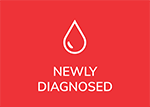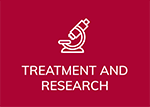I started epcoritamab, a bispecific antibody, in August 2023, and now, entering 2025, I continue to do well in complete remission (CR). But CLL cells are still detectable at the very low levels of one in a million. Officially I am in a CR dMRD6 with 1-2 cells per million detected in the blood by MRD (measurable residual disease) testing using genetic sequencing by clonoSEQ. I am undetectable by flow cytometry; in other words, uMRD4 or no cells are seen at the level of one in 10,000.
It is pretty darn good for single-agent immunotherapy in a tough case like mine.
I once again had the weird experience of seeing myself as one of the data points at an oral CLL presentation at a professional meeting. This time, my doctor, Alexey Danilov, was at the podium at the recent American Society of Hematology (ASH) 2024 Annual Meeting in San Diego in December, presenting Epcoritamab Monotherapy in Patients (Pts) with Relapsed or Refractory (R/R) Chronic Lymphocytic Leukemia (CLL): Results from CLL Expansion and Optimization Cohorts of Epcore CLL-1. In this trial, 100% of those who reached a CR were uMRD4 (7 of 7), and 6 of 7 were uMRD6.
After a difficult first 7 weeks with cytokine release syndrome and side effects from all the steroids, well documented earlier in this blog, it has been smooth sailing, with no side effects from my every 4-week shot in the belly. Lab remains perfect, other than the expected low immunoglobins (epcoritamab targets the healthy B cells that make our antibodies). That is not a trivial concern as it means I will not produce antibodies when vaccinated or fighting an infection. Not surprisingly, the deaths in the trials of the drug have been from infections. I continue to wear a mask.
The other concern is that the amount of CLL seen by clonoSEQ didn’t move much between 6 and 12 months. It is just holding the disease at a low stable albeit very low level. Will it stay stable or restart its past dramatic fall, or will my counts creep up soon? I am awaiting the results of my latest clonoSEQ MRD testing for the answers. And what then follows is more questions.
Right now, I am incredibly grateful for the deep response that I am enjoying. The buzz around the trial I’m in has been significant, and I was interviewed a few times about it.
The article from City of Hope is sweet, with a picture of Patty and me at the Huntington Garden. My interview with STAT News was more businesslike, the interviewer was excellent.
ASH was its usual wonderful frenetic whirlwind of attending lectures, learning from all the CLL oral presentations and poster sessions, being interviewed and doing interviews, sitting on committees and panels, helping lead CLL Society’s Medical Advisory Board annual in-person meeting, conferencing with friends in the pharmaceutical industry, connecting with new CLL doctors and new patient advocates, enjoying the occasional fun reception or meal with friends, and best of all, reconnecting with fellow advocates and researchers from across the globe and with the amazing CLL Society team.
Before I went to San Diego for ASH, I was topped up with IVIG and Pemgarda and seemed to have dodged yet another infection bullet despite attending a conference with 30,000 other people.
I am so lucky to have my care and all the support from my colleagues, especially my coworkers at CLL Society.
Happy New Year. 2025 is going to be great.
Stay strong, we are all in this together.
Brian Koffman, MDCM (retired), MS Ed


















12 Responses
Hi Brain
So glad your still in remission, did you say that your CLL was rather aggressive, the results are even more impressive
Fellow CLL er
Nurse in UK
I’m hoping for continued good news and health for you in the coming year.
Jeff Z
Congratulations Dr. Koffman. Thank you for your service which is vastly detectable and hugely appreciated together with Team CLL Society. ❤️
Such great news, Brian. Happy, Healthy New Year wished for you and yours!
Best wishes to you for a happy and continued infection free remission in the new year Dr. Koffman!
The information that you share provides tremendous hope for your fellow CLL patients.
Thank you for updating us on your health. It’s an encouragement to those of us that have CLL. We have been following you and the CLL society for 10 years, since I needed treatment. Diagnosed in Nov. 2020, but didn’t need treatment until the fall of 2014. Thankfully, I also have negative CLL cells in 1 in 10,000 since March of 2024. It took me 9 years to reach that with Acalabrutinib, which was just new when I began it in Dec. 2014. Blessings an you and the work you do for and with the CLL Society. It has been helpful and a blessing for us to have this site.
I echo Rich Weinstein’s comment. I’m so grateful for your service to our community. And so happy you are achieving these great results!
Congratulations! I needed to read your very good news. I have appreciated all the information you have shared and hope this is a long, long remission for you. My Mother always said that “All we send into the lives of others, comes back into our own”. Your story has given us a reason to hope and continue to fight this dragon and may all the good you have done come back to you, many times over.
Marilyn A
FCMR-2005
Ibrutinib/Venetoclax 2017-2019
Out of remission and MDA and local Oncologist agree I start Zanubrutinib
(My Father and my sister both had CLL)
im so glad you had a good response!. i am a bit confused though, can you really say you are in remission if there is still detectable cll albeit at a low level?
I had the experience of attending the earlier portion of ASH Annual Meeting called a CLL Symposium. A lot of great information, and reasons for optimism for treatment CLL patients going forward.
The highlight for me, was a brief discussion at the lunch table with Brian. He’s quite an inspiration, and we’re so lucky to have his advocacy.
Following you and hoping you stay in remission for a very long time. We are all rooting for you.
So good to see the treatment is still working, though the plateauing of the CLL level is not pleasant. Your August 2024 blog states, “Some mathematical modeling suggests that for every log (tenfold) reduction of the CLL, the benefit is one to two more years of remission.” So perhaps it just means the years of remission are also plateauing. Not a terrible outcome, given the 1 in 10^-6 level. Thank you very much for sharing your battle!